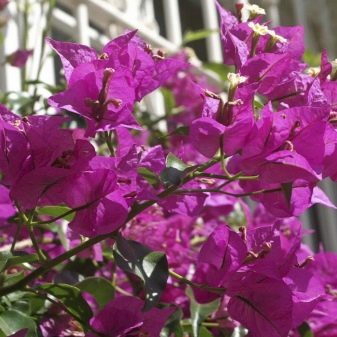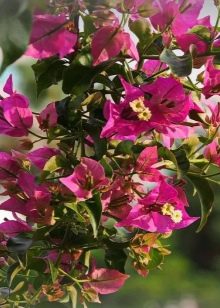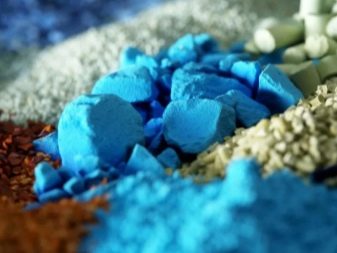All about bougainvillea street

Having learned all about street bougainvillea and having studied the description of the plant, gardeners significantly expand their opportunities to improve the plots. You must carefully read the cultivation, care and maintenance in the open field. In this case, the use of bougainvillea in landscape design will be most successful.

Description of the flower
Florists around the world are extremely pleased with this plant. There are only two things to remember:
- it is a classic vine;
- In many areas, bougainvillea street is difficult to grow due to its tropical origin (keeping at home is much easier).
Bougainvillea looks really unusual. She immediately adds bright colors to her surroundings and evokes associations with a colorful Latin American carnival. Bougainvillea is a perennial flowering plant that grows naturally mainly in South America. Botanically, these are climbing evergreen shrubs or trees of low height. In natural conditions, they can exceed 5 m.


Bougainvillea flowers are not too large. They are of the tubular type and are painted in bright colors, mainly purple or orange. Such flowers are grouped into small inflorescences. The decorative properties of the plant are associated with its impressive size bracts (they are also bracts). These bracts reach 30-50 mm in length, are very variable in shape and color, and most importantly, they stay on the plant much longer than real flowers.
Young branches of bougainvillea are especially flexible and well supported on supports. With their help, almost any geometric shapes are formed without problems. It blooms profusely from April to September. This species has large leaves, sometimes reaching 12 cm.



Planting and leaving
Since bougainvillea is a typical tropical plant, its cultivation and maintenance in the open field will be very difficult. Many gardeners gracefully get around this problem: they keep the culture in a tub for the main part of the year, and when the warm season comes, they place it outside or in the garden. In any case, it must be remembered that this species does not experience a temperature drop of more than 5 degrees Celsius. At such moments, the root immediately dies, and nothing can be done about it.
Normally, bougainvillea requires an abundance of heat and lighting. It is by these criteria that it is worth choosing a place for it. But good lighting alone is not enough, you will have to choose a spacious area that is not penetrated by the wind. In partial shade, and even more so in a thick shade, a Latin American guest will not grow. It is also necessary to avoid soils that are too infertile and saturated with clay.
Ideally, you should choose a site with slightly alkaline soil. If it is not there initially, then you need to purchase a ready-made planting mixture or make it yourself. Bougainvillea is planted strictly in the spring, because even when planting in the first decade of September, it will not have time to take root.
The notch is dug deeper to cover the bottom with a drainage layer. After placing bougainvillea in the pit, it should be sprinkled with a layer of soil and, having compacted, watered intensively.



Irrigation for a tropical plant in the summer should be active. Less zeal with this should be in the fall and spring months. But you should also take into account the actual weather. In winter, watering should be completely abandoned.However, periodic moistening of the soil in a heated room is still important in order to prevent it from drying out. For irrigation, use settled soft water without any impurities.
It must be understood that bougainvillea does not react well to excessive moisture. Watering with cold water is also undesirable for her. Such actions lead to root rot. In summer, irrigation is carried out twice a week in the evening hours, and only in dry moments the procedure is increased. It is also advisable to spray the crown, but this should be done, avoiding wetting the bracts.
For feeding bougainvillea, both mineral and organic products are used. From organic matter, the use of humus is recommended. It is laid immediately upon planting a bush. In the spring and autumn months, it is more correct to focus on mineral mixtures containing phosphorus.
Excess nitrogen is contraindicated as it leads to the development of green parts, which suppresses flowering.


It is necessary to illuminate an exotic culture in winter with scattered rays, supplementary lighting if necessary. Direct sunlight is preferred during the summer months. Abundant flowering is possible if the light period lasts at least 6 hours a day. In summer, it is advisable to keep the temperature within 21-27 degrees. In the spring, when there is active growth, it should be at least 10 degrees.
In winter, too much heating is contraindicated. In such cases, instead of a dormant period, the plant will choose to continue flowering. By the next season, it will be depleted, even if the soil is saturated with nutrients. A transplant is needed only when the development and growth stops. It is better not to touch the root complex during transplantation, it is also worth tune in to the long-term adaptation of bougainvillea - this is not a problem, but its species norm.

The pronounced climbing liana means the need to use supports. They turn out to be structures made of wire or bamboo. Supports are designed as carefully as possible. The size and shape are selected at your discretion. To protect bougainvillea from winter frosts, you must:
- remove the stems from the supports;
- cover them on the ground with a thick roofing material (15 cm or more) or a similar layer of spruce branches;
- mulch the roots with the same spruce branches or peat.

The tub culture must be moved to closed greenhouses.
Reproduction
For breeding bougainvillea, you can use layering from annual shoots. Anchoring to the ground is done using wire or wood staples. A circular incision helps to speed up root formation under the soil. Cuttings are advised to be cut in May and in the first decade of summer to a length of about 10 cm, with 3 or 4 leaves.
The sections are placed as close to the lower kidneys as possible. The planting material is placed in warm water and a root formation stimulator is used. Then the seedling prepared in this way is placed in a pot with a homogeneous peat-sand mixture. The dive goes to the second internode at an angle of 45 degrees. It is necessary to germinate the cutting at 25 degrees with systematic ventilation and humidification.
Seed propagation is labor intensive. It will take a long time. Seeds should be collected from mature and mature bushes. Sowing goes on containers with light, loose soil. Then the sown plants are covered with foil. We must not forget about systematic humidification and ventilation.


Diseases and pests
Yellow foliage often indicates excessive moisture. Too frequent replanting or adjustments in the direction of the shoots lead to the falling off of old foliage without the growth of replacing leaves. With root rot, they not only turn yellow, but also lengthen. Rescue is nearly impossible unless potent fungicides are used early enough. This is usually hindered by late diagnosis. Among insects, bougainvillea can be attacked by:
- aphids;
- scabbards;
- mealybugs;
- spider mites.


Use in landscape design
Bougainvillea is used for up to 10 years.The bushes planted on the southern sides of the greenhouses look most elegant. Mixing colorful plants is considered the most beautiful solution. You can also use bonsai: it will definitely look unusual. And in skillful hands, the liana will allow you to create arches and pergolas, it is also capable of wrapping around the gazebos.




























The comment was sent successfully.